![]() oday the North American indigenous peoples have emerged from the image of the “vanishing American”.
They are now increasingly visible in American life, most notably in the fields of contemporary art, music, dance, literature, theater and film. Daystar (Rosalie M. Jones), the Artist Director of Daystar: Contemporary
Dance-Drama of Indian America, is a choreographer and performer of Native American dance-drama, as well as a teacher and writer. Currently the Artist-in-Residence in the School of Arts and Performance, at the State
University of New York in Brockport, she has witnessed, over a period of thirty years, the on-again, off-again process of artistic success and failure, feast and famine, funding alerts and funding cuts, public adulation and public apathy.
oday the North American indigenous peoples have emerged from the image of the “vanishing American”.
They are now increasingly visible in American life, most notably in the fields of contemporary art, music, dance, literature, theater and film. Daystar (Rosalie M. Jones), the Artist Director of Daystar: Contemporary
Dance-Drama of Indian America, is a choreographer and performer of Native American dance-drama, as well as a teacher and writer. Currently the Artist-in-Residence in the School of Arts and Performance, at the State
University of New York in Brockport, she has witnessed, over a period of thirty years, the on-again, off-again process of artistic success and failure, feast and famine, funding alerts and funding cuts, public adulation and public apathy.
“You have always been a pioneer”. That is what people have been saying to me about my work, ever since I can remember. And what is that work? It is to develop, with this country’s indigenous young people, new ways to express both traditional and personal belief systems through the performing arts, and to share these discoveries with audiences from all walks of life”.
Tall, strikingly eloquent, naturally lyrical and soft spoken, Daystar, both on stage and off, has what theatre people call “presence”. Born on the Blackfeet Reservation in Montana, she is of 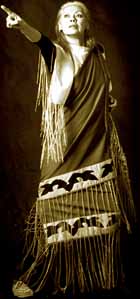 Pembina Chippewa ancestry on her mother’s side, and Welsh on her father’s side. At an early age Daystar was
“intrigued” by the stories her mother told her about her own youth growing up on the Blackfeet reservation. Random, intense revelations about family and tribal life: from the
smallpox epidemic of 1837, through the turn of the 20th Century, and into modern times.
Pembina Chippewa ancestry on her mother’s side, and Welsh on her father’s side. At an early age Daystar was
“intrigued” by the stories her mother told her about her own youth growing up on the Blackfeet reservation. Random, intense revelations about family and tribal life: from the
smallpox epidemic of 1837, through the turn of the 20th Century, and into modern times.
Her latest production, “No Home But The Heart,” draws from events in the lives of her great-grandmother, grandmother, and mother, and also highlights the resettlement of native peoples in the Northern Plains and Canada. This unusual mix of history, legend, and stage magic, premiered in Grand Rapids, Michigan, went on to a production in Santa Fe, New Mexico, and was revised and recently staged at the new Hartwall Dance Theatre at the State University of New York/Brockport; a stone’s throw from Rochester.
With a cast of gifted Native American performers from Santa Fe and Toronto, “No Home But The Heart” captures audience attention with its fresh mix of traditional tribal and contemporary dance, sharp tongued narration, solid acting, unexpected mime, chortling women’s calls, rapid fire costume changes, and crackling satirical wit and good humor. Written and conceived by Daystar, the production bridges cultural barriers, while keeping its roots intact. .
“Native North Americans have a high decree of artistic plurality. It is not unusual to find a visual artist who is also a professional musician, an actor and a working playwright. Or a educator who is also a painter and museum curator. Or an actor who is an activist, magazine publisher and film director. Perhaps this phenomenon is correlated to the fact that tribal communities always lived within a ceremonial life. Everyone participated and contributed to a higher goal that was at once spiritual, cultural, and artistic. The dancer, the singer, the storyteller, the artisan - breath, sing, dance, sculpt, and paint as nature does. Art is a natural, every day occurrence.”
Founded by Rosalie Jones in 1980 in Wisconsin, Daystar is the oldest professional Native American
contemporary dance company in the U.S. In the early 1990’s, Ms Jones revitalized the performing arts at the Institute of American Indian and Alaskan Arts in Santa Fe, when she was chair of the department. 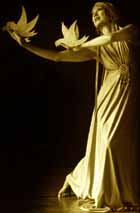 In 1995 she received a two year Choreographer’s Fellowship from the NEA. Since then the
groundbreaking choreographer has lectured , performed and toured throughout the United States, Canada, Turkey, Bulgaria, the Czech Republic, Germany, and recently, Finland.
In 1995 she received a two year Choreographer’s Fellowship from the NEA. Since then the
groundbreaking choreographer has lectured , performed and toured throughout the United States, Canada, Turkey, Bulgaria, the Czech Republic, Germany, and recently, Finland.
I asked her if there was any special event in her life that she remembers as inspirational. Her response is a lesson in achieving vision and maturity through artistic expression:
“An incident occurred early in my career that I never forgot. I called my first major solo dance ‘The Dispossessed’. It’s the dance story of an Indian woman who is taken from a reservation and put into a boarding school. A common practice at the turn of the century. After Indian people were subjected to life on the reservation, their children were forcibly taken away to be educated in “the white man’s ways”. The character I created through dance is taken advantage of in the work place because of her innocence and prejudice against Indians. She has a moment of enlightenment and returns to her tradition. When I presented this dance to Indian audiences I was nervous about people’s reactions. Reservation elders at that time often did not applaud stage performances. They were unfamiliar with contemporary stage rituals, and they stayed quiet out of respect for what you do. After my performance an elderly lady came up to me. She nodded her head, smiled and said was that “your vision”. I was stunned. She had seen my dance from within the cultural context; in other words, as a reflection of a “vision quest”. I realized then that this was my life’s work, that it had value, and that it was all right to do what I do. Her comment made me realize that what I was doing could communicate to both Indian and non-Indian audiences.”
NB: What is the origin of your stage name “Daystar”?
DAYSTAR: The Blackfeet people in Montana have a special reverence for the Sun. The star that shines through the day. Their legend is about a scarred man who took a journey to the Sun. At the home of the Sun he was healed, and then brought back to his people the ceremony of the Medicine Lodge. I felt it was appropriate to honor that name as a name for my own journey in life.
NB: In your program notes there is a quote that I would like to pass on to the readers.
DAYSTAR: It is a quotation from PEACEMAKER, the founder of the Iroquois Confederacy, 1000 AD “Think not forever of yourselves. Think of continuing generations of our families. Think of our grandchildren, of those yet unborn, whose faces are coming from beneath the ground.”.
The dual liturgy of Daystar’s life, the coming together of a Native American belief system, and the influence of her early school training with nuns, permeates everything she does on stage. It is also the background of her work with people from all walks of life.
“Native American people have volumes to speak, not only to non-Indian society, but to each other as well. I feel that all of us, Indian and non-Indian alike, could benefit, especially now, from Native American philosophy and life experience. I intend to continue not only as a performer, teacher, and choreographer, but also as a catalyst for cross-cultural understanding. “
In “Sacred Woman, Sacred Earth”, the production that put her name on the map, Daystar covers a wide range of Native American myth and legend; from sea to shining sea. In “The Woman Who Fell From The Sky”, a legend from the Six Nations people of the Northeast, the twin sons (Tayendah-neygah and Sungoyah-deesoh) represent the “duality” of good and ill in all of us. The word “evil” does not come into play. When the Woman falls from the sky and lands on the back of The Turtle (the continent of North America), it is a soft landing; danced by Daystar with grace and without unnecessary gravity.
To the eastern Cherokee and Penobscot peoples, the story of a beautiful woman nurturing a starving man physically and spiritually is central to the idea of respect for the earth. The story of Kanati (The Lucky Hunter) and Selu (The Corn Mother), Daystar believes, also represents a moment in human history when a transition was being made from hunting to agricultural societies. What gives the work its compelling attraction is that Selu is danced on toe shoes, with striking, elevating effect. The dance-drama highlights the emergence of the Corn Mother, who shakes her body to seed the earth, and gives up her life to feed her people.
In “The Gift of the Pipe”, another towering woman appears on the plains carrying a sacred bundle, bringing to the Lakota Sioux a way to pray to the Great Spirit – a gift of the Pipe. Even today the Pipe is still attended by the Keeper of the Pipe, and it is said that when it is approached, the ground thunders. The story is a classic metaphor of good triumphing over ill; sanity and good sense over ignorance and degradation. Daystar’s reenactment of the tribal legend captures the spirit of the story without violating its sacred nature.
In “Wolf: A Transformation” – 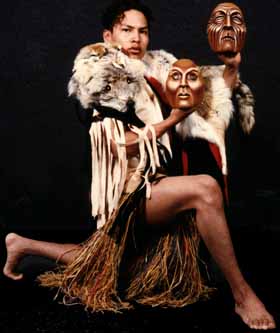 Daystar’s signature work – a
legend from the Anishinabe of the Great Lakes region, tells how the Creator gave the Wolf as the First Companion to the First Man. Daystar’s interpretation of the tale emerges through a transformational use of
multiple masks - within a framework of haunting music and striking animal dance imagery. “Wolf” reveals a gift for succinct theatrical expression, an awakening of human possibility, evolving from one state of being to the
next; of growing, surviving, illuminating, and, finally, the ultimate gift: revelation. It is as deeply internal as it is external. Exquisitely timed, “Wolf” never fails to rapture the audience; who often leave with a new sense of
respect for native cosmology that is both communal and refreshing.
Daystar’s signature work – a
legend from the Anishinabe of the Great Lakes region, tells how the Creator gave the Wolf as the First Companion to the First Man. Daystar’s interpretation of the tale emerges through a transformational use of
multiple masks - within a framework of haunting music and striking animal dance imagery. “Wolf” reveals a gift for succinct theatrical expression, an awakening of human possibility, evolving from one state of being to the
next; of growing, surviving, illuminating, and, finally, the ultimate gift: revelation. It is as deeply internal as it is external. Exquisitely timed, “Wolf” never fails to rapture the audience; who often leave with a new sense of
respect for native cosmology that is both communal and refreshing.
“Prayer of the First Dancer” is a swirling, almost groundless tribute to the importance of dance as healing expression. Combining a female dancer with hoops, a narrator who moves counterpoint, 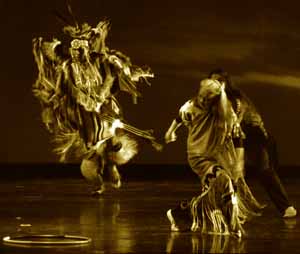 and a male “fancy” dancer swirling with high energy in brilliant regalia around
the commanding female figure, it movingly completes the journey of “Sacred Woman, Sacred Earth” with an anonymous prayer from the Lakota people to the Great Spirit. Daystar performs it with a lyrical command of
American Indian sign language used as dance notation. The spiritual nomenclature of the work rises above denominational clashes and doctrinaire hardening of the arteries. It affirms, without sanctimonious grab bagging, a
universal yearning for peace and spiritual bonding.
and a male “fancy” dancer swirling with high energy in brilliant regalia around
the commanding female figure, it movingly completes the journey of “Sacred Woman, Sacred Earth” with an anonymous prayer from the Lakota people to the Great Spirit. Daystar performs it with a lyrical command of
American Indian sign language used as dance notation. The spiritual nomenclature of the work rises above denominational clashes and doctrinaire hardening of the arteries. It affirms, without sanctimonious grab bagging, a
universal yearning for peace and spiritual bonding.
It can be difficult to make the decision to narrow the aesthetic focus in order to intensify the artistic and emotional intelligence. Through it all, the committed artist does what needs to be done – art, like life, continues. It doesn’t solidify into one form, it changes as life changes.
Creativity on a transformational level can be threatening. It doesn’t abide by the rules. For the artist, and from within the community the artist works for, risk taking and evolution is essential for survival, root understanding, and the incalculable gift of discovery. When the imagination grapples freely with primal forces, sound bites are unnecessary. When the art of the moment is full addressed, inspired by and connected to the community, it becomes universal. For Daystar: Contemporary Dance-Drama of Indian America, that commitment has been addressed. It flows like a rainbow across the stage, spreading light – a reflection of the sun.
[ Daystar’s website is at: www.acs.brockport.edu/~rjones/ ]
Ned Bobkoff
© 2001 Ned Bobkoff ALL RIGHTS RESERVED
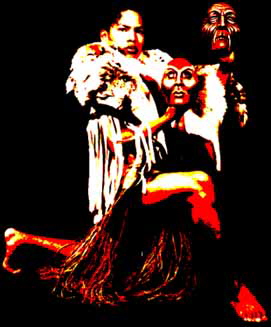


© 2000-2001 Aviar-DKA Ltd. All rights reserved (including authors’ and individual copyrights are indicated). No part of this material may be reproduced, translated, transmitted, framed or stored in a retrieval system for public or private use without the written permission of the publisher and the individual copyright holder. For permissions, contact publishers@scene4.com.
